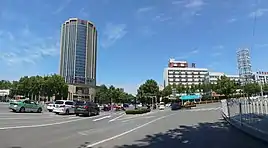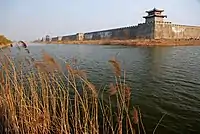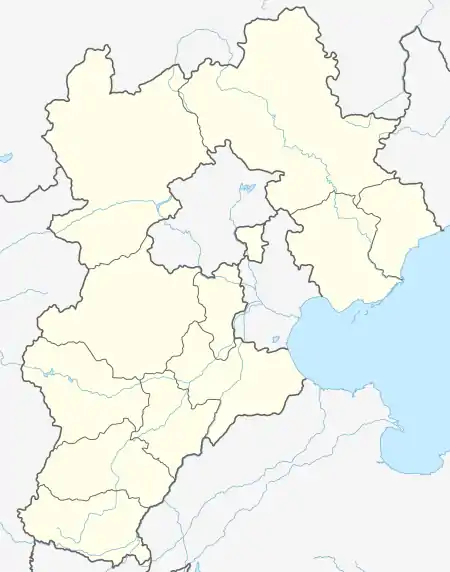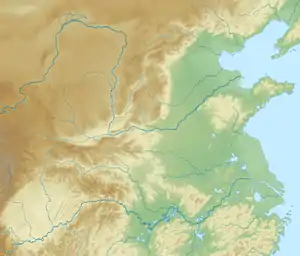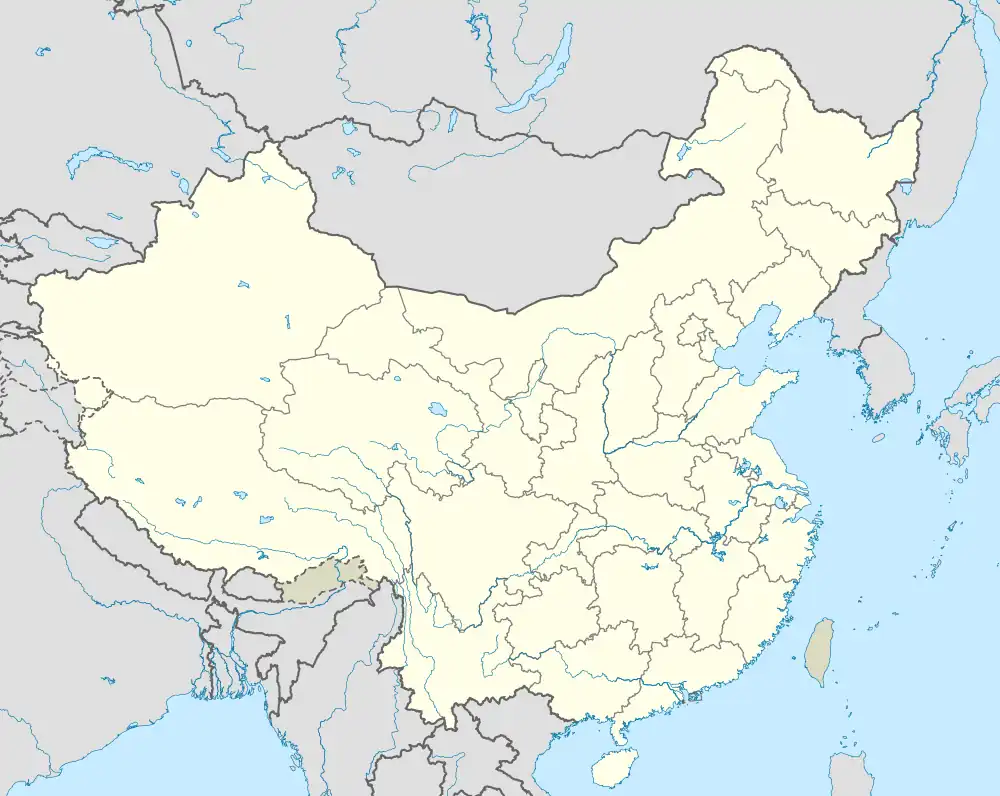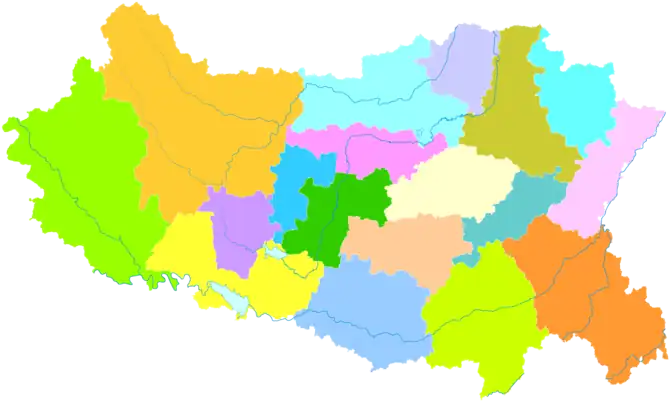Handan
邯郸市 Hantan | |
|---|---|
Clockwise from the top: Skyline of Handan, Guangfu Ancient City, Qibugou Scenic Area, wide view of downtown, Congtai Park, statue of foreign-clothed cavalry | |
| Nickname: Dream City (梦城) | |
.png.webp) Location of Handan City jurisdiction in Hebei | |
| Coordinates (Shanxi–Hebei–Shandong–Henan Revolution Memorial Park / (晋冀鲁豫革命纪念园): 36°36′04″N 114°29′13″E / 36.601°N 114.487°E | |
| Country | People's Republic of China |
| Province | Hebei |
| Settled | 6500 BC |
| Established | November 15, 1983 |
| Area | |
| • Prefecture-level city | 12,068 km2 (4,659 sq mi) |
| • Urban | 556.00 km2 (214.67 sq mi) |
| • Districts[1] | 2,649.1 km2 (1,022.8 sq mi) |
| Population (2020[2]) | |
| • Prefecture-level city | 9,433,000 |
| • Density | 780/km2 (2,000/sq mi) |
| • Urban | 2,845,790 |
| • Districts[1] | 4,012,000 |
| Time zone | UTC+8 (China Standard) |
| ISO 3166 code | CN-HE-04 |
| Vehicle registration | 冀D |
| Website | hd |
| Handan | |||||||||||||||||||||||||||
|---|---|---|---|---|---|---|---|---|---|---|---|---|---|---|---|---|---|---|---|---|---|---|---|---|---|---|---|
.svg.png.webp) "Handan" in Simplified (top) and Traditional (bottom) Chinese characters | |||||||||||||||||||||||||||
| Traditional Chinese | 邯鄲 | ||||||||||||||||||||||||||
| Simplified Chinese | 邯郸 | ||||||||||||||||||||||||||
| Postal | Hantan | ||||||||||||||||||||||||||
| Literal meaning | "the city at the terminus of Mount Han" | ||||||||||||||||||||||||||
| |||||||||||||||||||||||||||
Handan is a prefecture-level city located in the southwest of Hebei province, China. The southernmost prefecture-level city of the province, it borders Xingtai on the north, and the provinces of Shanxi on the west, Henan on the south and Shandong on the east. At the 2010 census, its population was 9,174,683 inhabitants whom 2,845,790 lived in the built-up (or metro) area made of 5 urban districts. Yongnian District in Handan and Shahe City in Xingtai have largely formed into a single conurbation.
Handan is one of the oldest cities in China, first settled in 6500 BC by the Cishan culture. Throughout the city's long history, it contributed significantly to Chinese culture, serving as the capital of State of Zhao, was northern China's political, economic and cultural center, and home to Tai chi and the first compass, made from stones collected in the nearby Mount Ci (magnet mountain). Handan is designated as one of China's National Famous Historical and Cultural Cities.[3][4][5][6]
Etymology
The city's name, Handan (Chinese: 邯郸), has remained unchanged for over 2,000 years. The name first appeared during the reign of King Zhou of Shang, in the chronicle Bamboo Annals.[7]
A dictionary from the Tang dynasty explained that "Han" (Chinese: 邯) is the name of a nearby mountain (Hanshan), and "Dan" (Chinese: 单) meant "the terminus of a mountain" with an added radical (Chinese: 阝) denoting a city. Together, "Handan" means "the city at the terminus of Mount Han". This explanation has been widely accepted until the discoveries of jade writings in Houma, Shanxi in 1965, where the "Dan" in Handan was spelt "丹", meaning red. This then lead to another explanation that Handan was named so because Mount Han appeared reddish-purple in color.[7]
The different spellings of the city's name consolidated into the modern spelling in Qin dynasty.[7]
History
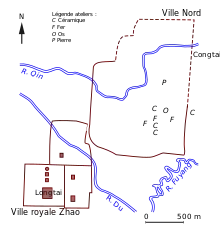
Handan, once well-defended from southern attack by a bend in the Zhang River, was a city of the state of Zhao during the Warring States Period (5th–3rd centuries BCE) of Chinese history. It was their second capital, after Zhongmu. King Wuling of Zhao turned Zhao into one of the Qin state's most stalwart foes, pioneering the use of walls to secure new frontiers (which would inspire the eventual construction of the Great Wall of China). The city was conquered by the State of Qin after the virtual annexation of Zhao by Qin except for the Dai Commandery. The first emperor of China, Qin Shi Huang was born in Handan, the child of a statesman from the state of Qin and after successfully conquering Zhao he ordered all enemies of his mother to be buried alive. The conquest of Zhao, particularly the Qin siege of Handan, is featured extensively in Chen Kaige's classic film, The Emperor and the Assassin.
At the beginning of the Han dynasty, Handan was Liu Bang's base for suppressing Chen Xi's rebellion in 197 and 196 BCE; it was still regarded as a regional center of culture and commerce at the end of the dynasty in the early 3rd century CE. It slowly declined, perhaps because of the numerous battles that ravaged northern China following the Han Dynasty, but maintained a reputation for its fine Cizhou ware well into the Qing dynasty (1644–1911). It was also the birthplace in the 19th century of Yang-style tai chi, one of Tai Chi's five major schools.
Though much of Handan's ancient history is no longer visible, it still has some attractions, deriving from the many Chinese idioms that the city inspired,[8] such as the road into which Lin Xiangru, courier of the precious Heshibi, backed in order to let his nemesis Lian Po pass first, as well as the location in which Lian Po begged for Lin Xiangru's forgiveness. Modern-day Congtai Park is located on the site of the historical Zhao court. Next to Congtai Park is the legendary "Xuebu Bridge" (学步桥), or "Learning to Walk Bridge". Legend has it that a noble from the state of Yan heard of a particularly elegant manner of walking unique to Handan. Arriving in Handan, he spent weeks trying to master the Handan style of walking on a bridge, only to fail. In the process, however, he had forgotten how to walk normally and had to crawl back to Yan. This story inspired the Chinese expression, "to learn the walk of Handan" (邯郸学步, Hándān xué bù), which means learning something difficult too intensely, thereby forgetting the basics in the process.[9]
The nearby Xiangtangshan Caves contain massive Buddha statues carved into the mountainside, some dating to the 6th century, many of which were severely damaged by invading Japanese forces during World War II. At that time, Handan was prized by the Japanese invaders for its coal reserves.
In 2007, Handan was the location of China's largest-ever bank robbery.
Administration
The population at the 2010 census was 941,427 for the 3 urban districts, 2,845,790 for the built up area and 9,174,683 for the entire Prefecture-level city area of 12,068 km2 (4,659 sq mi).
The municipal executive, legislative and judiciary are situated in Congtai District (丛台区, Cóngtái Qū), as well as the CPC and Public Security bureaux.
| Map | ||||||
|---|---|---|---|---|---|---|
| Name | Chinese | Pinyin | Population (2004 est.) | Area (km2) | Density (/km2) | |
| Congtai District | 丛台区 | Cóngtái Qū | 330,000 | 28 | 11,786 | |
| Hanshan District | 邯山区 | Hánshān Qū | 310,000 | 32 | 9,688 | |
| Fuxing District | 复兴区 | Fùxīng Qū | 250,000 | 37 | 6,757 | |
| Fengfeng Mining District | 峰峰矿区 | Fēngfēng Kuàngqū | 500,000 | 353 | 1,416 | |
| Feixiang District | 肥乡区 | Féixiāng Qū | 310,000 | 496 | 625 | |
| Yongnian District | 永年区 | Yǒngnián Qū | 860,000 | 898 | 958 | |
| Wu'an City | 武安市 | Wǔ'ān Shì | 720,000 | 1,806 | 399 | |
| 邯郸县 | Hándān Xiàn | 400,000 | 522 | 766 | ||
| Linzhang County | 临漳县 | Línzhāng Xiàn | 590,000 | 744 | 793 | |
| Cheng'an County | 成安县 | Chéng'ān Xiàn | 370,000 | 485 | 763 | |
| Daming County | 大名县 | Dàmíng Xiàn | 750,000 | 1,052 | 713 | |
| She County | 涉县 | Shè Xiàn | 390,000 | 1,509 | 258 | |
| Ci County | 磁县 | Cí Xiàn | 640,000 | 1,035 | 618 | |
| Qiu County | 邱县 | Qiū Xiàn | 200,000 | 448 | 446 | |
| Jize County | 鸡泽县 | Jīzé Xiàn | 250,000 | 337 | 742 | |
| Guangping County | 广平县 | Guǎngpíng Xiàn | 250,000 | 320 | 781 | |
| Guantao County | 馆陶县 | Guǎntáo Xiàn | 290,000 | 456 | 636 | |
| Wei County | 魏县 | Wèi Xiàn | 810,000 | 862 | 940 | |
| Quzhou County | 曲周县 | Qǔzhōu Xiàn | 410,000 | 667 | 615 | |
Climate
Handan has a monsoon-influenced humid continental climate/semi-arid climate (Köppen Dwa/BSk), with strong monsoonal influence, typical of the North China Plain. The normal monthly daily mean temperature ranges from −0.9 °C (30.4 °F) in January to 27.3 °C (81.1 °F) in July, while the annual mean temperature is 14.3 °C (57.7 °F). A majority of the normal annual precipitation of 502 mm (19.8 in) occurs in July and August.
| Climate data for Handan (1991–2020 normals, extremes 1981–2010) | |||||||||||||
|---|---|---|---|---|---|---|---|---|---|---|---|---|---|
| Month | Jan | Feb | Mar | Apr | May | Jun | Jul | Aug | Sep | Oct | Nov | Dec | Year |
| Record high °C (°F) | 19.7 (67.5) |
25.3 (77.5) |
31.7 (89.1) |
37.9 (100.2) |
40.0 (104.0) |
43.6 (110.5) |
42.0 (107.6) |
37.2 (99.0) |
40.1 (104.2) |
33.5 (92.3) |
28.6 (83.5) |
28.4 (83.1) |
43.6 (110.5) |
| Mean daily maximum °C (°F) | 4.2 (39.6) |
8.7 (47.7) |
15.3 (59.5) |
22.1 (71.8) |
27.7 (81.9) |
32.5 (90.5) |
32.5 (90.5) |
30.8 (87.4) |
27.3 (81.1) |
21.4 (70.5) |
12.8 (55.0) |
6.0 (42.8) |
20.1 (68.2) |
| Daily mean °C (°F) | −0.7 (30.7) |
3.1 (37.6) |
9.5 (49.1) |
16.1 (61.0) |
22.0 (71.6) |
26.6 (79.9) |
27.8 (82.0) |
26.2 (79.2) |
21.8 (71.2) |
15.5 (59.9) |
7.3 (45.1) |
1.1 (34.0) |
14.7 (58.4) |
| Mean daily minimum °C (°F) | −4.5 (23.9) |
−1.3 (29.7) |
4.3 (39.7) |
10.5 (50.9) |
16.2 (61.2) |
21.1 (70.0) |
23.6 (74.5) |
22.4 (72.3) |
17.3 (63.1) |
10.7 (51.3) |
3.0 (37.4) |
−2.8 (27.0) |
10.0 (50.1) |
| Record low °C (°F) | −15.0 (5.0) |
−14.4 (6.1) |
−6.1 (21.0) |
0.0 (32.0) |
7.7 (45.9) |
11.5 (52.7) |
16.5 (61.7) |
13.7 (56.7) |
5.4 (41.7) |
−1.0 (30.2) |
−11.4 (11.5) |
−12.7 (9.1) |
−15.0 (5.0) |
| Average precipitation mm (inches) | 3.2 (0.13) |
7.6 (0.30) |
9.8 (0.39) |
27.1 (1.07) |
40.8 (1.61) |
50.7 (2.00) |
147.0 (5.79) |
122.7 (4.83) |
46.5 (1.83) |
26.3 (1.04) |
14.9 (0.59) |
3.5 (0.14) |
500.1 (19.72) |
| Average precipitation days (≥ 0.1 mm) | 2.4 | 3.1 | 2.8 | 5.2 | 6.5 | 8.2 | 10.8 | 9.6 | 7.0 | 5.4 | 3.8 | 2.3 | 67.1 |
| Average snowy days | 3.7 | 3.0 | 1.1 | 0.2 | 0 | 0 | 0 | 0 | 0 | 0 | 1.3 | 2.7 | 12 |
| Average relative humidity (%) | 57 | 53 | 50 | 54 | 56 | 56 | 72 | 76 | 69 | 64 | 64 | 60 | 61 |
| Mean monthly sunshine hours | 133.1 | 149.2 | 198.5 | 222.3 | 252.7 | 228.4 | 192.1 | 193.7 | 179.5 | 177.0 | 144.3 | 138.0 | 2,208.8 |
| Percent possible sunshine | 43 | 48 | 53 | 56 | 58 | 52 | 43 | 47 | 49 | 51 | 48 | 46 | 50 |
| Source: China Meteorological Administration[10][11] | |||||||||||||
Economy
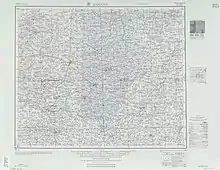
Handan has witnessed rapid growth over the past 20 years. Industrial growth in the city has focused on communication and transport activities. Handan is a major producer of coal and steel, with Coal mines at Fengfeng providing power for Handan's iron, steel and textile mills. Chemical and cement plants along with other industries also benefit. Local agriculture produces maize, pomegranates and eggs.[12] Handan also has a growing services sector, with retail, banking and trading making up 40% of the economy.[13] The GDP per capita in Renminbi was estimated at ¥13,449 in 2005. In 2015, the figure was ¥33,554.87.
Air pollution
According to a survey by "Global voices China" in February 2013, Handan was one of China's most polluted cities due to heavy industrial outputs.[14]
However the government has made a significant effort to make the city cleaner, which involved closing down many polluting power plants. It is no longer the most polluted city, and, according to a 2016 government survey, the number of good air quality days is 189 days, an increase of 135 days compared with 2013.[15]
Tourism
Handan Prefecture is home to the AAAAA tourist attractions Guangfu Ancient City and the Nüwa Imperial Palace.
Transportation
Handan is served by Handan Airport. Handan has two main train stations: one is Handan railway station which serves for the normal speed train, the other is named Handandong railway station, which serves for the high speed train.

Demographics
Ethnic minorities
According to Handan government in 2007, 40 ethnic groups were present in Handan. Ethnic minorities represent 50,000 people, among which 48,000 Hui. There are 22 Hui schools and 5 Hui junior high schools in Handan.[16]
Religion
The most widespread religion in Handan is Chinese folk religion, including Taoism and Buddhism.
In 2013, there were more than 150,000 Catholics in Handan according to the Catholic Church, in the Roman Catholic Diocese of Yongnian.[17] Mother of Grace Cathedral in Daming County was built in 1918. The most recent church was built in 2007.[18]
There are also 300,000 Protestants. The largest Protestant church is on Qianjin Avenue (邯郸市西堂) and was built in 1997.[19] The oldest church was on Congtai Street and was built in 1920. The church was destroyed in 2009 by the local government.[20] A new church was built in 2011.[21]
According to the local government 30,000 Hui Muslims live in the prefecture of Handan.[22]
Culture
Idioms
Handan is hailed as the capital of Chinese idioms.[23] As a prosperous city and cultural center during the Warring States period, Handan attracted many scholars. Over 1,500 idioms and proverbs are attributed to the city.[8] The following are some of the most well known idioms.
- 邯鄲學步 (literally: "to study the walking method of Handan"), meaning to badly imitate others, and lose one's individuality in the process.
- 黃粱一夢 (literally: "millet dream"), meaning a pipe dream.
- 頂天立地 (literally: "stand upright on one's two legs between heaven and earth"), meaning to be fiercely independent.
- 圍魏救趙 (literally: "to besiege the State of Wei to rescue the State of Zhao"), meaning to relieve a besieged ally by attacking the besiegers.
- 不可同日而語 (literally: "musn't speak of the two things on the same day"), meaning incomparable.
- 驚弓之鳥 (literally: "a bird frightened by the mere sound of shooting arrows"), a panic-stricken person.
- 鷸蚌相爭,漁翁得利 (literally: "when the snipe and the oyster fight, it is the fisherman that wins"), when two parties fight, it is always the third one who wins. King of Yan sent a representative to King Hui of Zhao to relay this message in order for him to rethink his plans of war.
- 曠日持久 (literally: "drawn out and protracted"), meaning to be protracted.
- 完璧歸趙 (literally: "returning the Jade to Zhao"), meaning to return something to its owner in good condition.
- 价值连城 (literally: "to be worth numerous contiguous cities"), meaning priceless.
- 怒髮衝冠 (literally: "one's hair raised to the hat in anger"), meaning to be furious.
- 負荊請罪 (literally: "carrying thorned grass and pleading guilt"), meaning to offer someone a humble apology.
- 紙上談兵 (literally: "to discuss military tactics on paper"), meaning to be an armchair strategist.
- 青出於藍,而勝於藍 (literally: "green is born of blue, but beats blue"), meaning to outmaster the teacher.
Notable people
- Lian Po, a military general of Zhao. Regarded one of the four greatest generals of the Warring States period.
- Lin Xiangru, politician of the Warring States period. He's featured in two idioms, "Returning the Jade to Zhao" and "Carrying Thorned Grass and Pleading Guilt".
- Xun Kuang, Confucianism philosopher.
- Xu Huaizhong, novelist.
- Qin Shi Huang, founder of the Qin dynasty and was the first Emperor of China.
- Cao Cao, Han chancellor, poet, and warlord. One of the central figures of the Three Kingdoms period.
- Huang Hua, senior Communist Chinese revolutionary. The county-level city of Huanghua, Cangzhou, was named after him.
- Feng Jianming, literature scholar.
- Fang Lijun, an artist based in Beijing.
- Yang Luchan, martial arts teacher.
- Deng Shu, father of Teresa Teng. He was a soldier of the Republic of China Armed Forces.
- Sun Qingmei, football player.
- Zhao Shi, football player.
- Zhang Weili, mixed martial artist, ring name "Magnum". She is the first ever Chinese and East Asian champion in UFC history.
- Chang Yongxiang, wrestler.
Sister cities
 Kryvyi Rih, Dnipropetrovsk, Ukraine[24][25]
Kryvyi Rih, Dnipropetrovsk, Ukraine[24][25] Padua, Veneto, Italy (1988)
Padua, Veneto, Italy (1988) Saiki, Ōita, Japan (1994)
Saiki, Ōita, Japan (1994) Dubuque, Iowa, United States (1995)
Dubuque, Iowa, United States (1995) Miryang, South Gyeongsang, South Korea (2004)
Miryang, South Gyeongsang, South Korea (2004) Ust-Ilimsk, Irkutsk Oblast, Russia
Ust-Ilimsk, Irkutsk Oblast, Russia
References
- 1 2 3 4 Ministry of Housing and Urban-Rural Development, ed. (2019). China Urban Construction Statistical Yearbook 2017. Beijing: China Statistics Press. p. 46. Retrieved 11 January 2020.
- ↑ 河北11市最新人口排名出炉 唐山排第四 - 政策 -唐山乐居网. ts.leju.com. Retrieved 22 July 2018.
- ↑ "Handan, China". City of Dubuque. Retrieved 2020-03-15.
- ↑ "磁山——指南针的故乡". Handan Cultural Net. Retrieved 2020-03-15.
- ↑ "永年:太极之乡文化"醉人"". Wenming.cn. Retrieved 2020-03-15.
- ↑ "河北最内敛的城市, 河北南大门, 2016年GDP列河北第五". 温柔小胖虎. 18 April 2018. Retrieved 2020-03-15.
- 1 2 3 "河北邯郸市:一座盛产成语典故的千年古都". 河北日报. Retrieved 2020-03-20.
- 1 2 "City of the idiom". 2011-10-14.
- ↑ "Chinese Word: 邯郸学步". Purple Culture. Retrieved 2020-01-28.
- ↑ 中国气象数据网 – WeatherBk Data (in Simplified Chinese). China Meteorological Administration. Retrieved 25 August 2023.
- ↑ 中国气象数据网 (in Simplified Chinese). China Meteorological Administration. Retrieved 25 August 2023.
- ↑ Patton, Dominique. "China's chickens need to lay a billion eggs a day. Here's how..." U.K. Retrieved 2018-08-30.
- ↑ "Handan (Hebei) City Information | HKTDC". china-trade-research.hktdc.com. Retrieved 2018-08-30.
- ↑ Bildner, Eli (February 27, 2013). "Interactive Maps of China's Most–and Least–Polluted Places". Global Voices China. newsmotion.org. Archived from the original on 3 September 2014. Retrieved 1 September 2014.
- ↑ Xu, Hui (徐辉). 【治霾·京津冀在行动】邯郸六大战役推动大气污染深度治理. CCTV-NEWS (in Simplified Chinese).
- ↑ 邯郸概貌 (in Chinese (China)). Handan People's Government.
- ↑ Fides, Agenzia. 亚洲/中国 - 河北邯郸(永年)教区六位执事晋铎 - Agenzia Fides. www.fides.org (in Simplified Chinese). Retrieved 22 July 2018.
- ↑ "邯郸市南门里天主教堂". Archived from the original on 2014-08-26. Retrieved 2014-08-26.
- ↑ 基督教 (in Chinese (China)). Ethnic Affairs Commission of Hebei Province. Archived from the original on 10 November 2016. Retrieved 22 July 2018.
- ↑ 杜树杰同志在全区三年大变样"百日攻坚大会战"动员大会上的讲话 (in Chinese (China)). Handan People's Government. Archived from the original on 3 September 2014. Retrieved 22 July 2018.
- ↑ 邯郸市基督教北关教堂简史_河北省-邯郸市-基督教会-北堂 -邯郸基督教北堂 (in Chinese (China)). Christian Church of Handan. Retrieved 22 July 2018.
- ↑ Chinanews.com Hebei 邯郸建成千人回族幼儿园 服务流动少数民族 (in Chinese (China)). 2011-11-29.
- ↑ 海纳百闻 "中国成语典故之都"在哪里? (in Chinese (China)). 2019-12-27.
- ↑ Города-побратимы. Нижний Тагил. Администрация Нижнего Тагила.
- ↑ Перелік державних та муніципальних сайтів. Kryvyi Rih City. Archived from the original on 2014-11-29.
External links
- City of Handan, Official site Archived 2012-08-05 at the Wayback Machine
